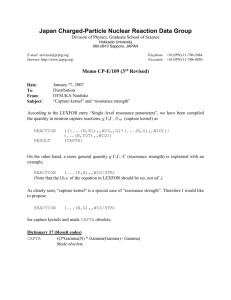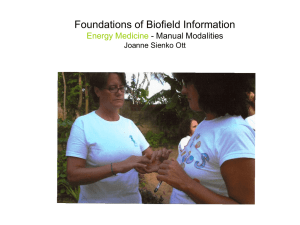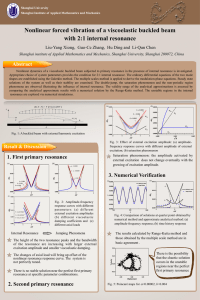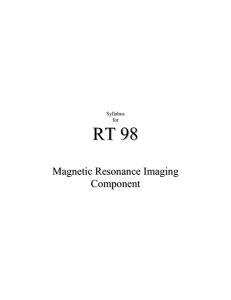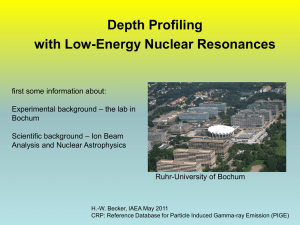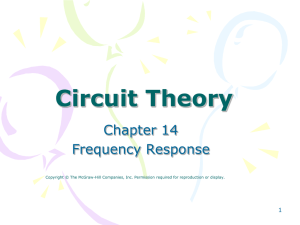109rev4 - IAEA Nuclear Data Services
advertisement
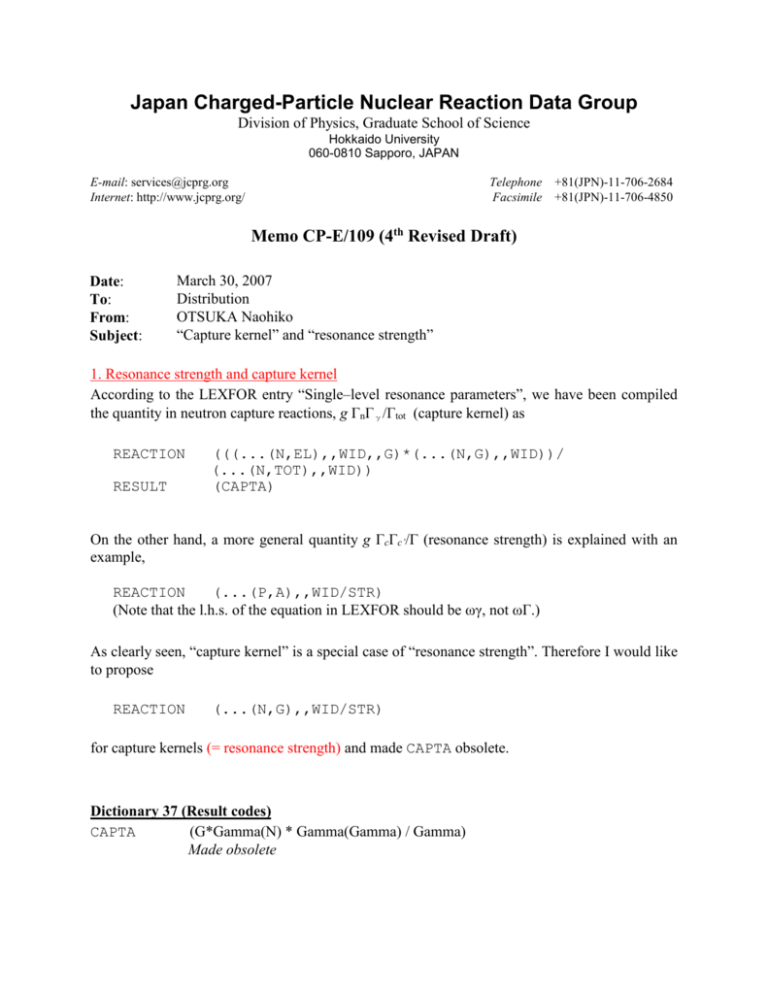
Japan Charged-Particle Nuclear Reaction Data Group Division of Physics, Graduate School of Science Hokkaido University 060-0810 Sapporo, JAPAN E-mail: services@jcprg.org Internet: http://www.jcprg.org/ Telephone Facsimile +81(JPN)-11-706-2684 +81(JPN)-11-706-4850 Memo CP-E/109 (4th Revised Draft) Date: To: From: Subject: March 30, 2007 Distribution OTSUKA Naohiko “Capture kernel” and “resonance strength” 1. Resonance strength and capture kernel According to the LEXFOR entry “Single–level resonance parameters”, we have been compiled the quantity in neutron capture reactions, g ГnГγ/Гtot (capture kernel) as REACTION RESULT (((...(N,EL),,WID,,G)*(...(N,G),,WID))/ (...(N,TOT),,WID)) (CAPTA) On the other hand, a more general quantity g ГcГc’/Г (resonance strength) is explained with an example, REACTION (...(P,A),,WID/STR) (Note that the l.h.s. of the equation in LEXFOR should be ωγ, not ωГ.) As clearly seen, “capture kernel” is a special case of “resonance strength”. Therefore I would like to propose REACTION (...(N,G),,WID/STR) for capture kernels (= resonance strength) and made CAPTA obsolete. Dictionary 37 (Result codes) CAPTA (G*Gamma(N) * Gamma(Gamma) / Gamma) Made obsolete In my observation, “capture kernel” and “resonance strength” have been used by neutron and charged-particle people respectively. My friend working for nuclear astrophysics at Bruxelles knows only “resonance strength”, and my colleague working for neutron capture measurement at JAEA knows only “capture kernel”. We can see an interesting example in P.E. Koehler, Phys. Rev. C66 (2002) 055805. He is an experimentalist of neutron measurements at ORELA in Oak Ridge and analyzes his data of neutron total and capture cross section of magnesium to study 22Ne(α,n)25Mg which is regarded as the neutron source in s-process. In this article, he uses “capture kernel” for neuron induced reaction and “resonance strength” for α induced reaction. He agrees with me about my observation that “capture kernel” and “resonance strength” are familiar to neutron reaction people and charged-particle reaction people, respectively. I also propose revision for the LEXFOR entry “Single-level resonance parameter”, where I add corrections over the entry in order to correct misspelling in equations , add definitions of some variables and some relevant analysis codes. Due to insufficient explanation of codes in dictionary, some codes are sometimes applied improperly. (e. g. SHAPE for shape of decay curve, shape of response function, …). 2. Resonance strength with a modified statistical factor Usually statistical factor g appearing in the definition of resonance strength (capture kernel) is g=(2J+1)/[(2Ji+1)(2Jt+1)], where J, Ji and Jt are spin of resonance, incident projectile and target, respectively. However some authors use a modifier statistical weight (2J+1) in place of (2J+1)/[(2Ji+1)(2Jt+1). We can see discussion about two conventions in D.J. Hughes, Phys. Rev. 94(1954)740. So I propose a new modifier and new quantity code for the resonance strength with this modified statistical factor. Dictionary 34 (Modifiers) RG times spin degeneracies of incident particle and target Dictionary 236 (Modifiers) ,WID/STR,,RG (2Ji+1)(2Jj+1)*resonance strength Quantity ,WID/STR,,RG Type RP Dimension Reference E J. Keinonen et al., Phys.Rev.C15(1977)579 Subentry Distribution: S. Babykina, CAJaD S. Dunaeva, IAEA-NDS A. Hasegawa, NEA-DB K. Katō, JCPRG V. McLane, NNDC P. Obložinský, NNDC V. Pronyaev, CJD S. Taova, VNIIEF M. Wirtz, IAEA-NDS J.H. Chang, KAERI S. Ganesan, BARC H. Henriksson, NEA-DB Y.O. Lee, KAERI A. Mengoni IAEA-NDS Y. Ohbayasi, JCPRG D. Rochman, NNDC T. Tárkányi, ATOMKI H.W. Yu, CNDC M. Chiba, JCPRG Z.G. Ge, CNDC A. Kaltchenko, KINR S. Maev, CJD M. Mikhaylyukova, CJD A. Ohnishi, JCPRG O. Schwerer, IAEA-NDS V. Varlamov, CDFE V. Zerkin, IAEA-NDS F.E. Chukreev, CAJaD O. Gritzay, KINR J. Katakura, JAEA V.N. Manokhin, CJD C. Nordborg, NEA-DB N. Otuka, JCPRG S. Tákacs, ATOMKI M. Vlasov, KINR Y.X. Zhuang, CNDC Single-Level Resonance Parameters See also Average Resonance Parameters, Quantum Numbers, Multilevel Resonance Parameters. Resonance cross sections as a function of energy may be described using a Breit-Wigner singlelevel formalism. For s-wave scattering the formula is: 2 c / 2 R' sc ( E ) 4 g 4R' 2 (1 g ), ( E E 0 ) i / 2 0 2 0 2 sct R sc ( E ) 4 g 4 R2 1 g ( E E0 ) i / 2 0 2 0 g where 4π R'2 0 0 J Ji 2J 1 , (2 J i 1)( 2 J t 1) = σpot = de Broglie wavelength at the resonance energy, = 0 / 2π = 1/k (inverse of wave number), = spin of resonance, = spin of incident projectile, Jt = spin of target, For reactions (capture, fission, etc.): c c ' E cc ' ( E ) g 0 , 2 2 E ( E E0 ) ( / 2) 1/ 2 E c c cc ( E ) 402 g 0 2 2 E E E0 2 1/ 2 2 0 where c = channel for formation of compound nucleus c = channel for decay of compound nucleus For further detail see References 1 and 2. … Resonance widths (Γr) REACTION Coding: WID in SF6 (parameter) and the code for the reaction described in SF3 Examples: (...N,TOT),,WID) = total width (Γ) (...(N,EL),,WID) = neutron width (Γn) (...(N,G),,WID) = capture width, or radiation width (Γγ), including all primary γ decays not followed by a neutron or charged-particle emission. If the resonance have a clear shape (no overlap with nearby resonances), shape analysis (SHAPE) is applicable, or else area analysis (AREA) or R-matrix formalism (RFN) are major methods. Analysis method may be entered under the information-identifier keyword ANALYSIS. Units: a code from Dictionary 25 with the dimension E (e.g., EV). For partial radiation width, see Gamma Spectra. ... … Peak cross section is defined as a cross section at the peak of the resonance, assuming the line shape in a Breit-Wigner formalism, corrected (where important) for instrumental and temperature effects. The peak cross section for s-wave neutrons can be expressed by: 0c 420 g Total: c , 0 420 g Partials: 0 cc 0 c c c 2 These are coded with the modifier code RES in combination with the code for the reaction described. Example: (...(N,TOT),,SIG,,RES) Total peak cross section Resonance area (cross section integrated over the resonance) defined: For scattering: Asct 2 220 g For other reactions: c2 . c c ' . c c REACTION coding: the parameter code ARE in combination with the relevant reaction code. Acc ' 2 220 g Acc 2 202 g Units: a code from Dictionary 25 with the dimension B*E (e.g., B*EV). Example: (...(N,EL),,ARE) Scattering area The quantity (ΓnΓγ)/Γ is often presented as a result of the resonance analysis and is proportional to the capture area. It is coded the reaction combination followed by the keyword RESULT, using the code CAPTA. Units: a code from Dictionary 25 with the dimension E (e.g., EV). Example: REACTION (((....(N,EL),,WID,,G)*(....(N,G),,WID))/ (....(N,TOT),,WID)) RESULT (CAPTA) Resonance Strength The resonance strength is defined as: g ω where: γ c c ' , 2J 1 c c (2 ji 1)(2 jt 1) = statistical weight factor (=g) = channel dependent width (ГcГc’/Г) Resonance strength for capture reaction may also be called capture kernel or capture area Aγ. Resonance strengths are determined experimentally by measuring the area under the resonant yield curve over the resonance: 2 Y c' 20,cm ( E )dE nt , or by measuring the thick target yield where 2 Mt Yc ',thick , 2 0 M t M i 2 Ac Y R Ac Ac r nt = number of atom per unit area of target ε = stopping power Mt = mass of target, Mi = mass of incident projectile, Yc’ = yield for channel c’ REACTION Coding: the parameter code, WID/STR in SF6. Units: a code from Dictionary 25 with the dimension E, e.g., EV Example: (...(P,G),,WID/STR) resonance strength for proton capture Partial resonance strengths are given for transitions to a specific energy level. Examples: (……(N,G),PAR,WID/STR) resonance strength for a given level excitation. … Sometimes resonance strength is reported with a modified statistical factor (2J+1), (2 J 1) c c ' . This may be coded with a modifier RG. Example: (...(P,G),,WID/STR,RG) (2J+1) ГpГγ’/Г for proton capture

